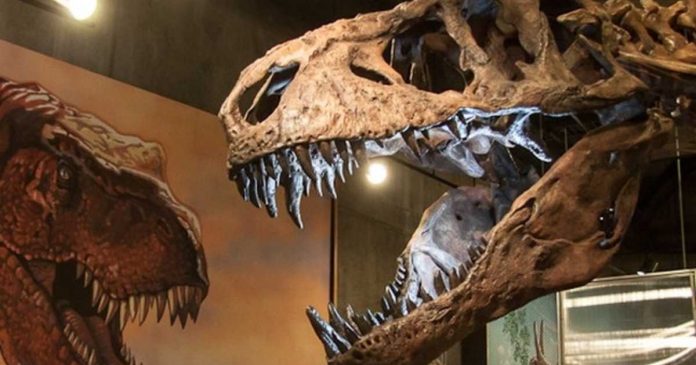He was 13 meters long, over twice as tall as you and weighed almost nine tons, back when he lived in Saskatchewan 66 million years ago. Despite his imposing bulk, he had clearly suffered in life – and was he fat?
Scotty, the biggest T-rex found to date, had injuries, whether from prey that resisted or fellow predators. Perhaps it was also predictable that, as the paleontologists put it, “There is considerable size variability among Tyrannosaurus. Some individuals were lankier than others and some were more robust. Scotty exemplifies the robust.”
His skeleton was found back in 1991, but extracting a tyrannosaurus from encasing rock using micro-tools is time-consuming. After a decade of painstakingly chipping away, one might assume the University of Alberta paleontologists nicknamed the mega-rex Scotty after their intrepid first author W. Scott Persons. But they did not. The dinosaur was named for a celebratory bottle of scotch the night he was discovered, the scientists explain in The Anatomical Record.
They elaborate that after “careful measurements” of legs, hips, and even shoulder, Scotty comes out “a bit heftier” than other T-rex specimens.
Sue, the previous record-holder of biggest T-rex, had measured 12.3 meters nose to tail-tip and stood 4 meters tall. She had been nicknamed not for an alcoholic beverage or a science-denying politician, but for the explorer who discovered her in South Dakota, Sue Hendrickson.
Much argument subsequently ensued about whether Sue (the T-rex, not the explorer) was lanky or beefy: the relatively recent analyses have leaned toward the lean. Scotty, on the other hand, seems to have been a load.
They are also unsure about T-rex and the sexes. One might assume Scotty is male and Sue is female, but it isn’t necessarily so.
Once upon a time, paleontologists thought T-rexes might have had sexual dimorphism and that the robust ones were the ladies, which needed wider pelvises to lay their eggs. Upon discovering that latter-day crocodiles are not consistently sexually dimorphic, however, it is becoming clearer that we cannot make any assumptions about tyrannosauruses or any other dinosaurs. They may have been dimorphic, they may not have been, or some may have been.
A paleontologist spearheading the criticism of dinosaurial dimorphism, Jordan Mallon, explained in Paleobiology in 2017 that there were clearly sexual differences: if a dinosaur skeleton is found with fossil eggs in the fossil abdomen, the dinosaur was female. But his examination of nine dinosaur species found no sexual dimorphism – though he meticulously adds that it may well have existed, we just haven’t found the evidence yet.
The bottom line is we cannot make blank assumptions and in short, we don’t know that Sue was female or that Scotty is male.
As for Scotty, the scientists also claim that he or she is the oldest T-rex found to date. “By which I mean, it would have had the most candles on its last birthday cake,” Persons said. “You can get an idea of how old a dinosaur is by cutting into its bones and studying its growth patterns. Scotty is all old growth.” Which means he died in his 30s, they estimate.
Turtles and some sharks may live hundreds of years but not the predatory mega-dinosaurs, which experienced short, intense and violent lives. Marks left on his mineralized bones led the paleontologists to conclude that Scotty experienced broken ribs, an infected jaw, and somebody had badly bitten his tail. We do not know who.













